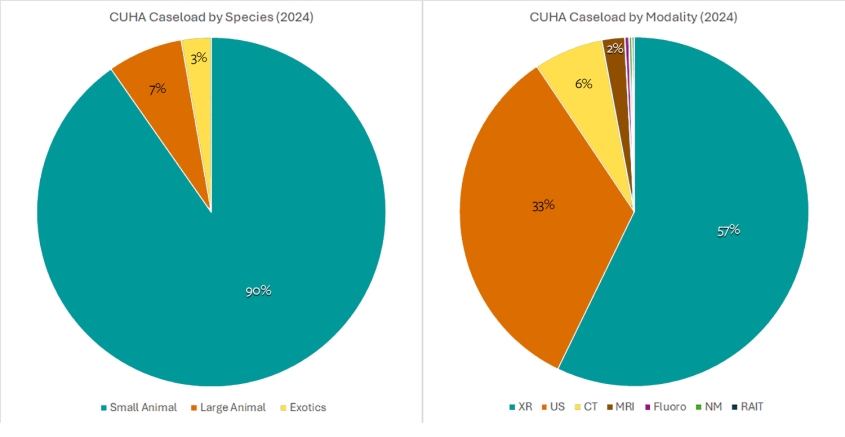Veterinary Diagnostic Imaging Residency Program
Program Overview
ACVR Accredited: Our program is accredited by the American College of Veterinary Radiology (ACVR).
Duration: A 3-year program starting each July.
Personnel: Six board-certified veterinary radiologists offer mentorship alongside seven licensed technicians providing crucial support.
On-site Training: Radiology, fluoroscopy, ultrasonography, nuclear medicine, computed tomography (CT), magnetic resonance imaging (MRI), and radioiodine treatment (RAIT) for feline hyperthyroidism.
Species: Small animals, large animals, and exotic animals.
Class Size: Seven residents are currently enrolled (with plans to increase to nine in two years).
Achievement: Successful completion qualifies candidates for the ACVR board-certification examination.
Career Pathways: Prepares candidates for roles in academia, specialized practice, or teleradiology.
Candidates: One candidate will be accepted this year through the matching program.
Prospective Applicants
Application Process
- All applications are managed through the Veterinary Internship and Residency Matching Program unless otherwise specified.
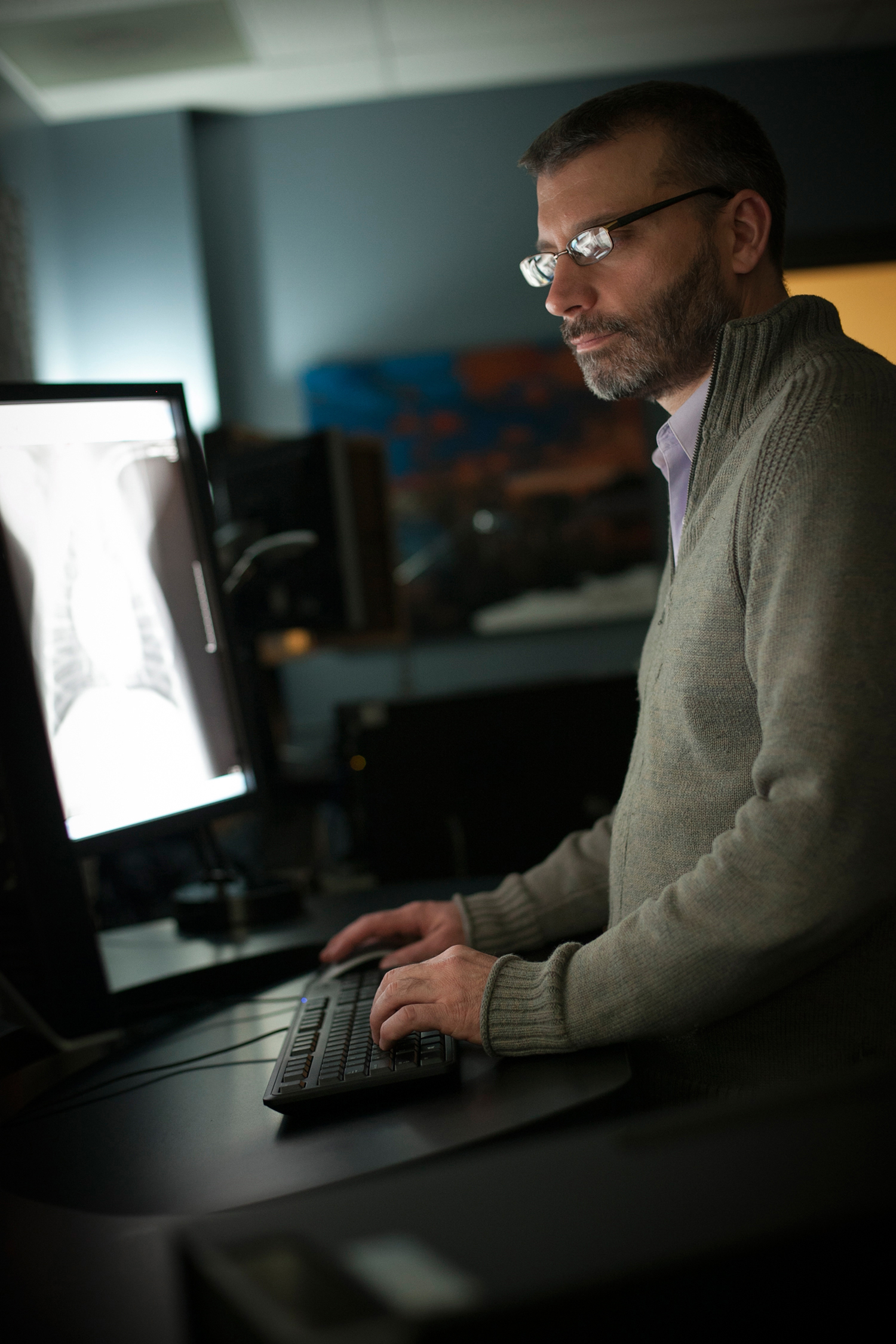 Prerequisites
Prerequisites
- Degree in veterinary medicine
- Minimum one-year post-graduation clinical experience; completion of an internship is strongly encouraged. Completion of a specialty internship is not required.
- Proficiency in English (both written and spoken).
Eligibility for Foreign Applicants
- Applicants from both foreign and American colleges of veterinary medicine are welcome, provided work authorization parameters are met.
- Clinical positions at Cornell are open to US citizens, US Permanent residents, Canadian citizens, or foreign nationals with valid employment authorization documents (EAD in hand).
- Sponsorship for H1B status is possible, subject to Department of Labor requirements. Sponsorship cannot be guaranteed.
- For questions about requirements or eligibility, please contact Ms. Pilar Thompson (pav37@cornell.edu).
Campus Visits
- We regret that campus visits will not be arranged this year. While visiting Cornell is not a prerequisite for acceptance, selected candidates may be invited for a virtual meeting if additional information is needed. However, virtual or phone meetings at the candidate's request will not be conducted.
Program Inquiries
- Candidates with program-related questions may email Dr. Chris Tollefson (crt76@cornell.edu).
- Candidates with questions about AIS sponsorship may email Keith Acquino (Keith.Acquino@antechdx.com).
- Applicants attending the annual ACVR Scientific Meeting are encouraged to interact with the Imaging Faculty and current residents present.
Virtual "Meet and Greet"
- After receiving all applications, a virtual session will be scheduled for all applicants. Details will be communicated via email. This optional meeting offers a chance to discuss the program with current residents and learn about life in Ithaca, NY.
Application Preparation
- Letter of Intent: Emphasize motivation for pursuing a residency in veterinary diagnostic imaging, how the program aligns with future career goals, and what unique skills you bring.
- Letters of Recommendation: Ideally from a board-certified veterinary radiologist and current supervisors. Recommendations should address cognitive/clinical reasoning, technical, and communication/interpersonal skills.
Selection Criteria
- The program is highly competitive. Successful candidates exhibit self-motivation, leadership, adaptability, and strong time management skills. They possess a high GPA/rank, robust internship or equivalent experience, and provide compelling letters of intent and recommendation. The ability to work effectively with diverse animal species and individuals is essential.
- While not mandatory, publications, research, and teaching experience might enhance an applicant's standing in the final selection process.
Program Statistics
Completion and Board Certification
Nearly all 30 residents who completed the program are board certified, attaining a 97% overall success rate.
First Attempt Success Rates
- 82% passed the preliminary examination on their first attempt (27 out of 33).
- 73% achieved success in the certifying examination on their first try (22 out of 30).
- 70% of residents passed the entire examination on their initial attempt (21 out of 30).
These statistics underscore the effectiveness and high standards of our program, ensuring our residents are well-prepared for their board certification examinations.
Why Choose Cornell?
Located in the picturesque Finger Lakes region of New York State, Cornell University stands as a distinguished research institution with a legacy spanning over 150 years. As an integral part of this esteemed university, the College of Veterinary Medicine is globally recognized for its contributions to veterinary medicine, public health, biomedical research, and veterinary education. Embracing diversity, inclusivity, and community outreach, the College's faculty, staff, and students are not only highly skilled but also compassionate advocates for exceptional care at our cutting-edge teaching hospital. Our post-graduate program in veterinary diagnostic imaging is both demanding and comprehensive, offering dedicated facilities for the five core imaging modalities in veterinary medicine. With a diverse caseload spanning small, large, and exotic animals, residents gain invaluable hands-on experience. Supported by a faculty of eight board-certified veterinary radiologists, two ACVR/RO Diplomates, and a team of expert veterinary specialists, our Imaging Faculty provide direct mentoring, participate in daily case rounds, and engage in timely case discussions. The Cornell University Hospital for Animals benefits from seven skilled imaging technicians, ensuring seamless support for our residents. Established in 1999, our residency program boasts a history of success, with graduates consistently achieving outstanding pass rates for the ACVR board-certification examination. Many of our alumni hold esteemed academic positions and have become leaders in the field. Additionally, the Imaging Section offers a comprehensive online teaching file, access to a vast collection of online journals, and specialized software for direct feedback and report comparison. Choosing Cornell means joining a legacy of excellence in veterinary diagnostic imaging and gaining access to unparalleled resources for professional growth.
Why choose Cornell for a Veterinary Imaging residency program (video with transcripts)
Facilities
Cornell University provides a diverse and extensive array of clinical settings across three locations. While the residency training is at the Cornell University Hospital for Animals, additional opportunities for specialized experiences at the other facilities (Cornell Ruffian Equine Specialists in Elmont, NY and Cornell University Veterinary Specialists in Stamford, CT) are possible. Moreover, Cornell University residents enjoy access to the extensive resources offered by the Flower-Sprecher Veterinary Library. This robust network of facilities and materials ensures that residents receive a comprehensive and diverse clinical education.
Imaging Modalities
Our extensive range of advanced diagnostic equipment ensures precise and comprehensive diagnostics for our patients, reflecting our commitment to providing the highest quality care. These cutting-edge technologies are seamlessly integrated through DICOM modality worklist via our electronic medical record system and accessible through Carestream PACS. Carestream PACS includes both diagnostic and browser-independent web software accessible both on-site using modern workstations and off-site for at home reading. Our PACS offers robust CT multiplanar reconstruction software, 3D rendering software, and integrated voice dictation within it’s streamlined report system. Edits made by faculty to resident preliminary reports are available for review using an easy-viewing reports program allowing side-by-side comparison with tracked changes.
Radiography
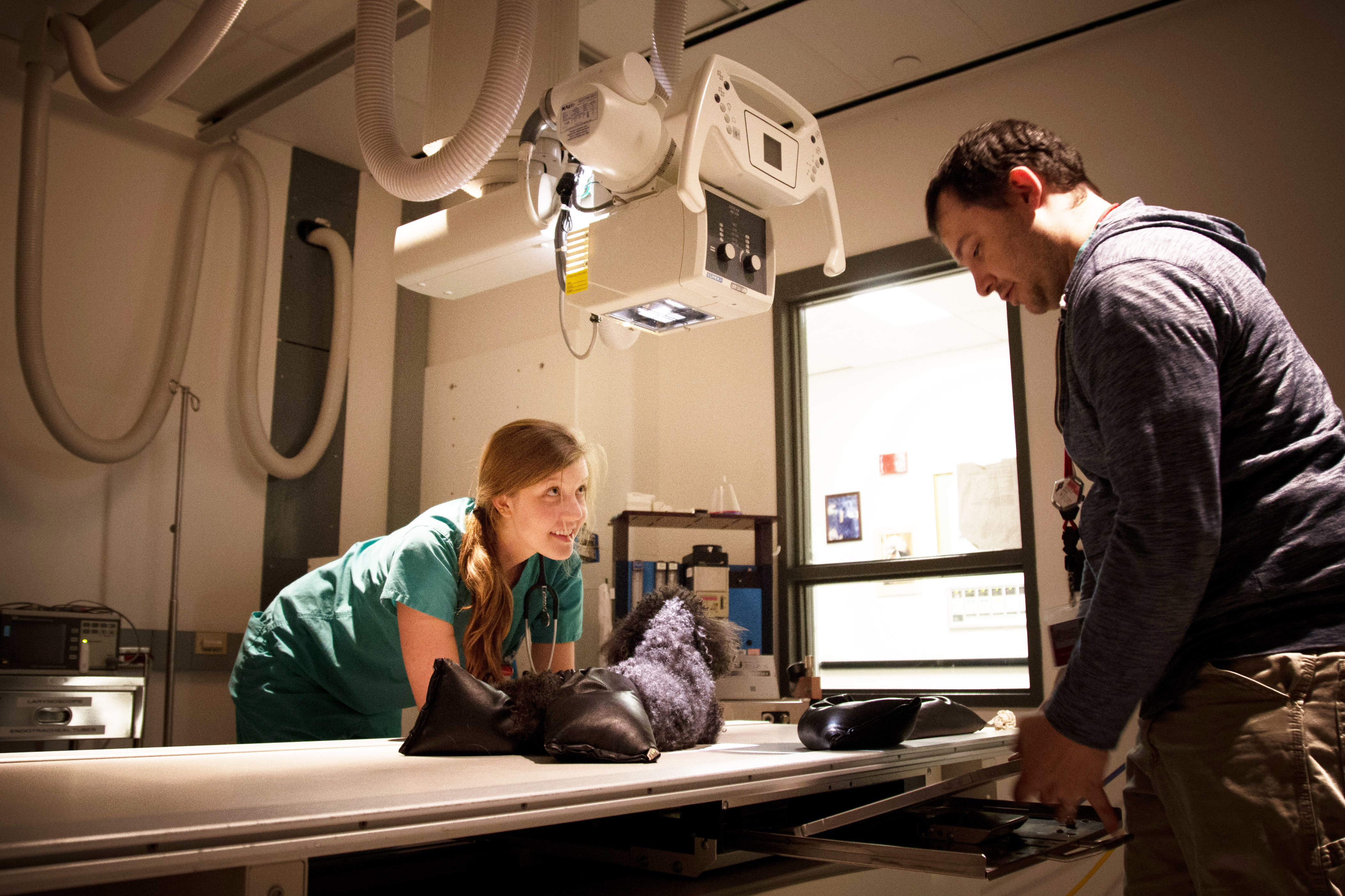 Three small animal digital radiography suites
Three small animal digital radiography suites- Large animal digital radiography suite and portable digital radiography system
Fluoroscopy
- Multi-purpose fluoroscopy system integrated into a digital radiography suite
- Two mobile C-arm fluoroscopy systems
Ultrasonography
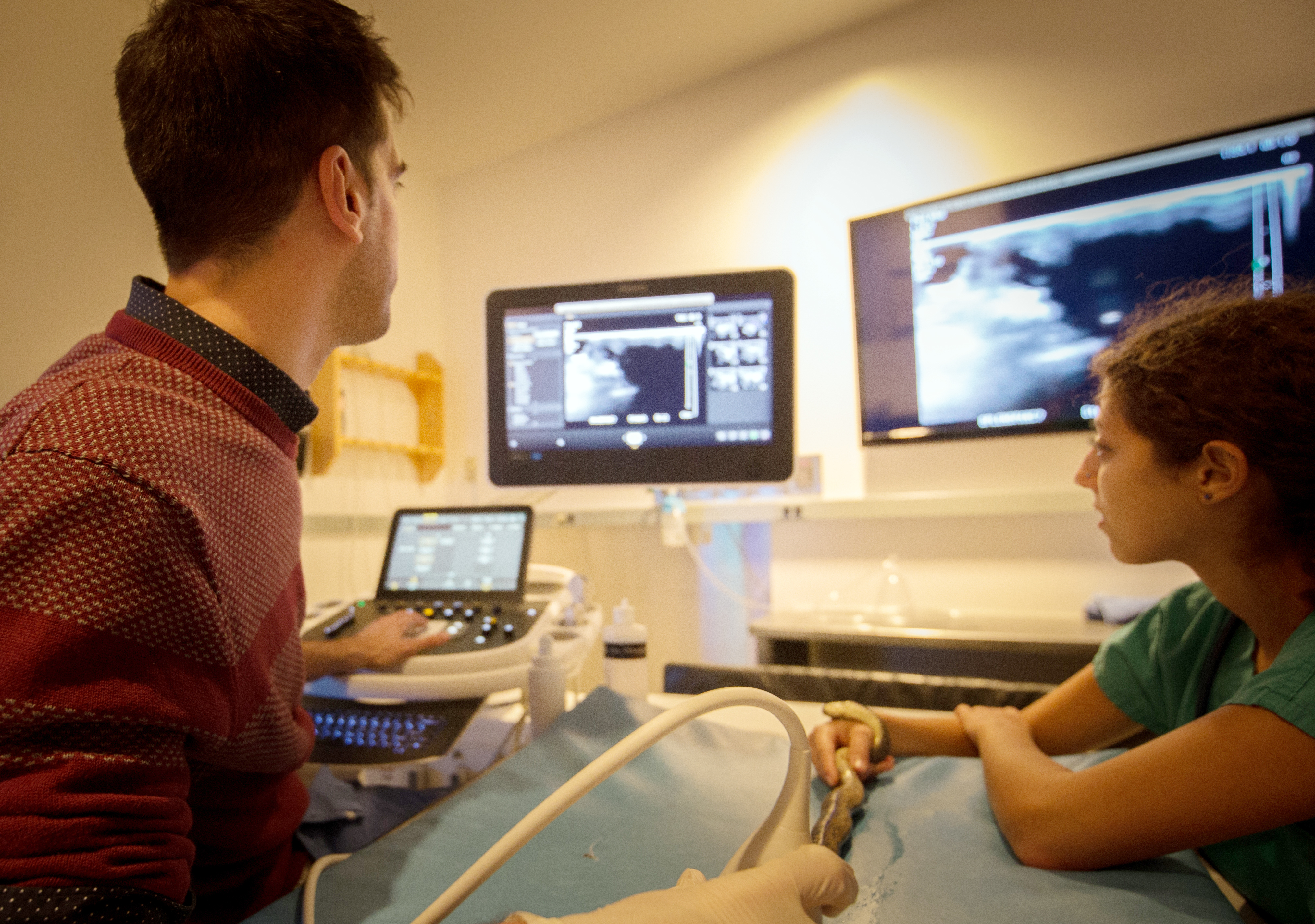 Samsung RS85 Prestige ultrasound system (Samsung Medison Co. Ltd., Hongcheon, Korea)
Samsung RS85 Prestige ultrasound system (Samsung Medison Co. Ltd., Hongcheon, Korea)- Epiq 5 Ultrasound (Phillips Healthcare, Cambridge MA)
- IU22 Ultrasound (Philips Healthcare, Cambridge MA)
Nuclear Medicine/Scintigraphy
- Equine Scanner H.R. NM Scanner (MiE medical imaging electronics, Elk Grove Village, IL)
- Geiger counters
Computed Tomography (CT)
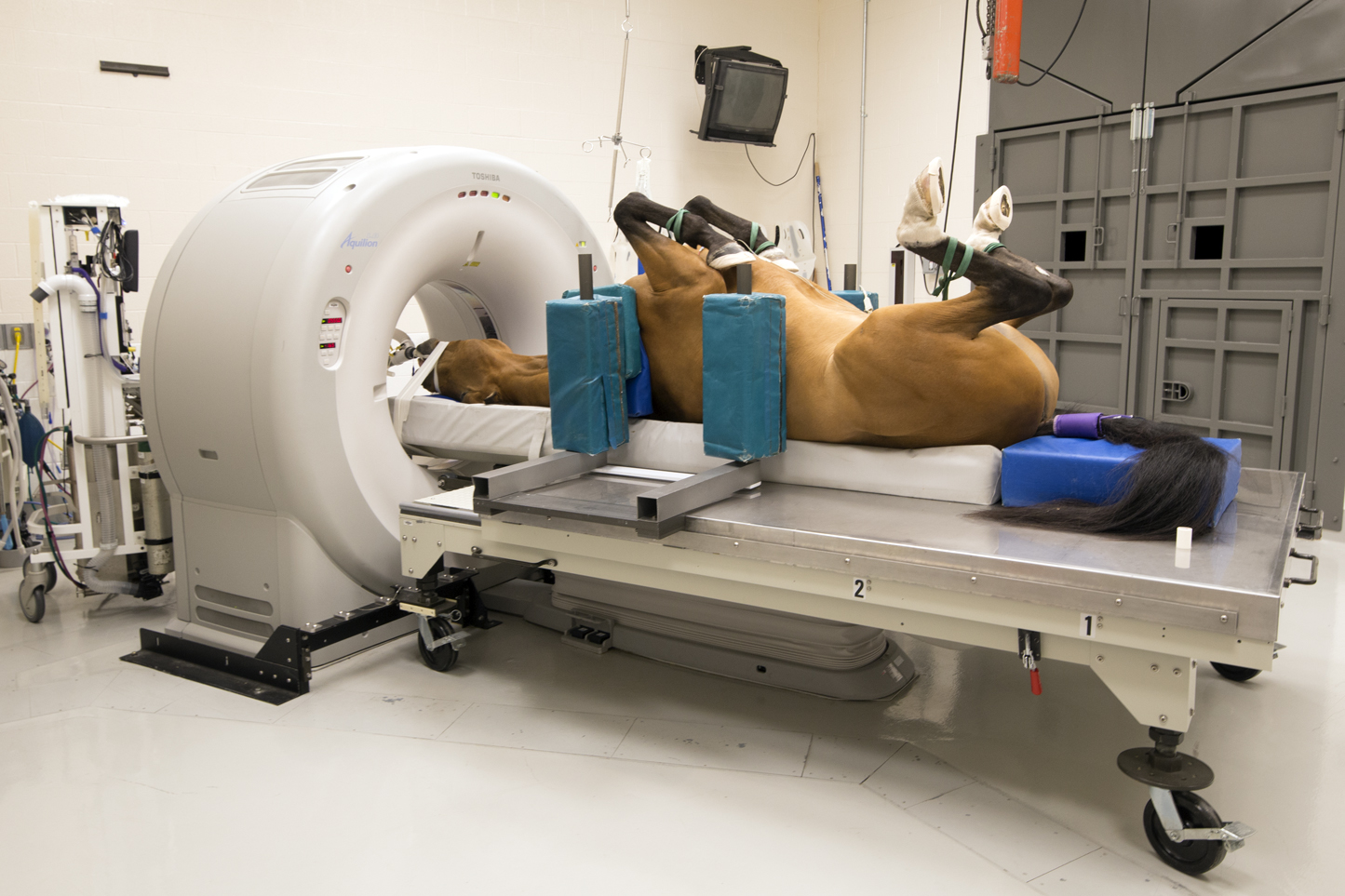 Siemens Naeotom Alpha Photon Counting CT system with Syngo VIA (Siemens Medical Solutions, Malvern, PA) with large animal capabilities and a power injector system for CT angiography
Siemens Naeotom Alpha Photon Counting CT system with Syngo VIA (Siemens Medical Solutions, Malvern, PA) with large animal capabilities and a power injector system for CT angiography
Magnetic Resonance Imaging (MRI)
- Vantage Orian 1.5 T MRI scanner (Canon Medical Systems USA, Inc. Tustin, CA)
- Discovery MR740 3.0 T Research MRI scanner (GE Healthcare, Waukesha, WI, USA)
We have made significant strides in our facilities, recently upgrading our MRI scanner with the latest imaging technology. Looking ahead, we will be replacing our existing CT scanner, introducing a state-of-the-art linear accelerator for radiation therapy, and creating a new interventional radiography suite. These advancements reaffirm our commitment to top-tier patient care and the forefront of veterinary medicine.
Clinical Learning Opportunities
Our program places the clinical caseload at the heart of the educational journey. This encompasses the entire imaging process, from the preparation and execution of imaging studies to the thorough interpretation of results, and generation of an accurate and meaningful written report. Active participation in daily case rounds and dedicated follow-up on cases further enhance the educational process. This dynamic structure ensures that the curriculum adapts seamlessly to the evolving caseload, offering residents a diverse range of learning opportunities throughout the program. Each day brings fresh opportunities for residents to take ownership of their learning path, engaging actively through various avenues and adaptable pacing. This empowering approach creates a rich and immersive educational experience.
Residents are entrusted with delivering thoughtfully prepared case presentations during rounds and within the hospital setting, with a primary focus on elucidating the importance of imaging signs and their direct implications for patient management. Whenever possible, thorough preparation for rounds entails a comprehensive review of relevant clinical data, including test results, and an examination of pertinent literature. Additionally, residents are encouraged to actively participate in spontaneous discussions on a wide array of topics, initiated by students, technicians, and clinicians. This proficiency nurtures critical thinking and hones effective communication skills in a clinical context. Adhering to this structured approach to case presentations ensures a comprehensive and enriching educational experience for all participants involved.
Caseload
Annually, the Cornell University Hospital for Animals (CUHA) attends to about 35,000 animals and 20,000 imaging examinations. These include roughly 90% small animals, 7% large animals, and 3% exotic species. Additionally, our caseload benefits from access to an Antech Imaging Services virtual teleradiology rotation. Each resident generates an average of 2000 written reports per year. Preliminary reports are typically completed within 24 hours and are subsequently reviewed by a board-certified radiologist.
On-Call Experiences
Providing on call emergency support in our residency program provides crucial educational opportunity. It cultivates independence, requiring residents to make critical decisions and manage cases autonomously, while always having a board-certified veterinary radiologist available for backup. This experience refines clinical judgment, exposes residents to diverse and challenging cases, and encourages practical problem-solving. It also sharpens time management and communication skills, offering hands-on experiential learning. Moreover, on-call duty instills confidence in crisis management and prepares residents for the responsibilities they will assume as board-certified veterinary radiologists, closely simulating the demands of professional practice. Importantly, on-call duties are shared fairly among the residents, ensuring an equitable learning experience for all.
Structured Learning Opportunities
Curated Content
We offer tutorials and supplementary study materials covering the areas specified in the ACVR Board Certification Content Outline and Study Guide. This ensures our residents have access to comprehensive resources for their educational development and board certification preparation.
Known Case Conference (KCC)
- 18 cases KCC: sessions are held twice annually, coinciding with semi-annual assessments. These sessions provide residents with an opportunity to practice their abilities in a scenario mimicking the ACVR certification examination. As the resident progresses throughout the program, these sessions provide moments of reflection to highlight the growth of a radiologist through residency.
- 6 cases KCC: sessions are conducted once or twice in other months in both written and oral formats, ensuring a minimum of nine sessions per year. This focused conference format enhances diagnostic skills, encouraging discussion on effective case presentation, presents unique and classic imaging cases, and helps prepare residents for the ACVR certifying examination.
Educational Events
- Journal Club (Monthly): A regular forum for in-depth discussions on the latest research, discussion of influential imaging manuscripts, and fosters critical analysis and evidence-based practice.
- CUCVM Rounds (Weekly): Weekly rounds provide an opportunity for interactive learning and case reviews in multiple disciplines of veterinary medicine, promoting cross-section collaboration and collective problem-solving.
- Imaging Seminars (Monthly): Monthly resident and faculty led seminars delve into specific imaging topics, offering a deeper understanding of advanced techniques and methodologies.
Additional Learning Opportunities
Teaching Participation
Residents will actively contribute to the DVM curriculum in various capacities, ensuring a minimum participation in designated courses. This includes:
- VTMED 5100 - The Animal Body (Fall, 12 credits)
- VTMED 5520 - Diagnostic Imaging (Spring, 2 credits)
- VTMED 5610 - Radiology Service (Fall, Winter, Summer, Spring, 2 credits)
Moreover, each resident is expected to prepare and deliver a minimum of three lectures, seminars, or scientific presentations over the course of the residency program. Opportunities may arise within the DVM curriculum, in providing continuing education for veterinarians or technicians, or presenting at scientific conferences. This active engagement in teaching is essential for residency training as it cultivates strong communication skills and the ability to effectively convey complex concepts to peers and students. It also promotes a deep understanding of the subject matter, reinforcing the resident's expertise in veterinary diagnostic imaging. Furthermore, participation in teaching and educational activities aligns with the role of a mentor and educator, which is integral for future careers in academia and clinical practice.
Research Endeavors
Engaging in research projects is pivotal to understanding how advancements in knowledge directly impact patient care. Residents are encouraged to partake in a research project, with the level of involvement contingent on factors such as professional aspirations, available funding, and project dynamics. Collaborating with a faculty mentor(s), the resident is typically involved in:
- Designing the study
- Preparing a grant proposal for funding
- Obtaining Institutional and Animal Care Use Committee (IACUC) approval
- Conducting data collection and statistical analysis
- Presenting an abstract at the ACVR conference or an equivalent forum
- Publishing results in a peer-reviewed journal
Additionally, imaging residents are expected to complete the University's formal Responsible Conduct of Research foundational course online, covering essential topics like authorship, peer review, plagiarism, and research misconduct.
Calendar Overview
- Residents are required to complete a minimum of 24 months in the residency program, including at least 20 months in clinical service, before becoming eligible to take the preliminary board examination.
- For eligibility to take the certifying board examination, residents must complete a minimum of 36 months in the residency program, including at least 30 months in clinical service.
- Residents are entitled to two weeks of vacation within the year (July to July). More details below. It is essential to seek prior approval for vacation time to ensure proper coordination of schedules.
- Besides on-the-job mentoring, we hold semi-annual feedback and review sessions (A).

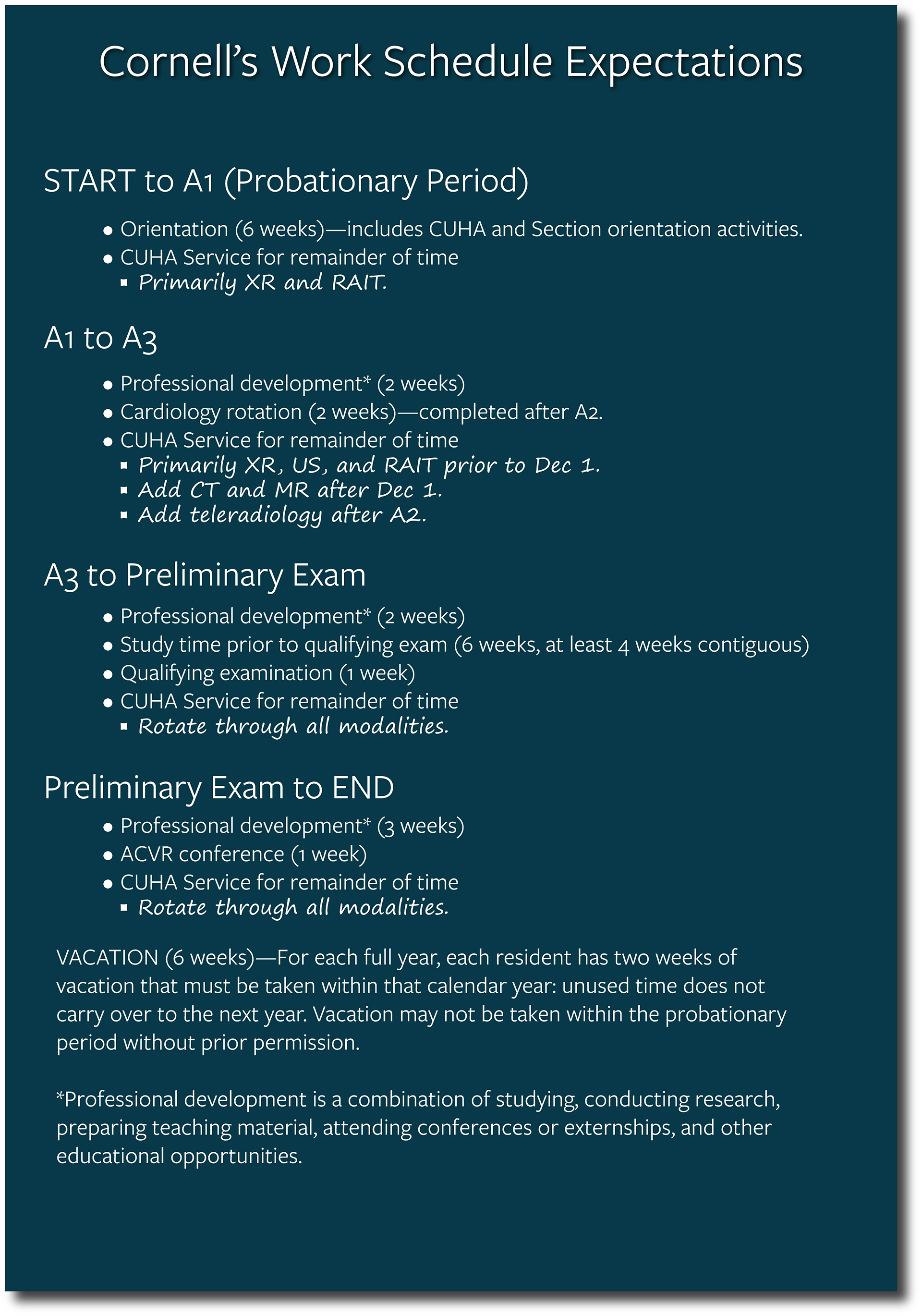
Additional Expectations
In addition to clinical responsibilities, residents are expected to dedicate a significant portion of their time to academic pursuits. This includes rigorous study, participating in book clubs, and staying abreast of the latest advancements in medical literature. Some of these activities may extend beyond regular hours and into weekends. The radiology faculty may assign additional duties or tasks on an as-needed basis to further enrich the resident's learning experience. It's important to note that if necessary, and in compliance with the requirements of both the ACVR and CUHA Residency Oversight Committee, the radiology faculty reserves the right to make program adjustments without prior notice. This flexibility ensures that the program remains dynamic and tailored to the evolving needs of our residents.



